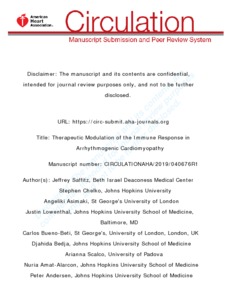Chelko, SP;
Asimaki, A;
Lowenthal, J;
Bueno-Beti, C;
Bedja, D;
Scalco, A;
Amat-Alarcon, N;
Andersen, P;
Judge, DP;
Tung, L;
et al.
Chelko, SP; Asimaki, A; Lowenthal, J; Bueno-Beti, C; Bedja, D; Scalco, A; Amat-Alarcon, N; Andersen, P; Judge, DP; Tung, L; Saffitz, JE
(2019)
Therapeutic Modulation of the Immune Response in Arrhythmogenic Cardiomyopathy.
Circulation, 140 (18).
pp. 1491-1505.
ISSN 1524-4539
https://doi.org/10.1161/CIRCULATIONAHA.119.040676
SGUL Authors: Asimaki, Angeliki
![[img]](https://openaccess.sgul.ac.uk/111230/1.hassmallThumbnailVersion/Circulation_Main%20Text%20and%20Figures.pdf)  Preview |
|
PDF
Accepted Version
Available under License ["licenses_description_publisher" not defined].
Download (25MB)
| Preview
|
Abstract
Background: Inflammation is a prominent feature of arrhythmogenic cardiomyopathy (ACM), but whether it contributes to the disease phenotype is not known. Methods: To define the role of inflammation in the pathogenesis of ACM, we characterized NFκB signaling in ACM models in vitro and in vivo, and in cardiac myocytes from patient induced pluripotent stem cells (hiPSCs). Results: Activation of NFκB signaling, indicated by increased expression and nuclear accumulation of phospho-RelA/p65, occurred in both an in vitro model of ACM (expression of JUP2157del2 in neonatal rat ventricular myocytes), and in a robust murine model of ACM (homozygous knock-in of mutant desmoglein-2; Dsg2mut/mut) that recapitulates the cardiac manifestations seen in ACM patients. Bay 11-7082, a small molecule inhibitor of NFκB signaling, prevented development of ACM disease features in vitro (abnormal redistribution of intercalated disk proteins, myocyte apoptosis, release of inflammatory cytokines) and in vivo (myocardial necrosis and fibrosis, LV contractile dysfunction, ECG abnormalities). Hearts of Dsg2mut/mut mice expressed markedly increased levels of inflammatory cytokines and chemotactic molecules which were attenuated by Bay 11-7082. Salutary effects of Bay 11-7082 correlated with the extent to which production of selected cytokines had been blocked. NFκB signaling was also activated in cardiac myocytes derived from a patient with ACM. These cells produced and secreted abundant inflammatory cytokines under basal conditions, and this was also greatly reduced by Bay 11-7082. Conclusions: Inflammatory signaling is activated in ACM and it drives key features of the disease. Targeting inflammatory pathways may be an effective new mechanism-based therapy for ACM.
| Item Type: |
Article
|
| Additional Information: |
This is a non-final version of an article published in final form in Chelko, SP; Asimaki, A; Lowenthal, J; Bueno-Beti, C; Bedja, D; Scalco, A; Amat-Alarcon, N; Andersen, P; Judge, DP; Tung, L; et al. (2019) Therapeutic Modulation of the Immune Response in Arrhythmogenic Cardiomyopathy. Circulation, 140 (18). pp. 1491-1505. |
| Keywords: |
NF-kappaB signaling, arrhythmogenic cardiomyopathy, 1103 Clinical Sciences, 1102 Cardiovascular Medicine And Haematology, 1117 Public Health And Health Services, Cardiovascular System & Hematology |
| SGUL Research Institute / Research Centre: |
Academic Structure > Molecular and Clinical Sciences Research Institute (MCS) |
| Journal or Publication Title: |
Circulation |
| ISSN: |
1524-4539 |
| Language: |
eng |
| Publisher License: |
Publisher's own licence |
| Projects: |
|
| PubMed ID: |
31533459 |
| Dates: |
| Date |
Event |
| 2019-10-29 |
Published |
| 2019-09-19 |
Published Online |
| 2019-08-14 |
Accepted |
|
 |
Go to PubMed abstract |
| URI: |
https://openaccess.sgul.ac.uk/id/eprint/111230 |
| Publisher's version: |
https://doi.org/10.1161/CIRCULATIONAHA.119.040676 |
Statistics
Item downloaded times since 24 Sep 2019.
Actions (login required)
 |
Edit Item |



